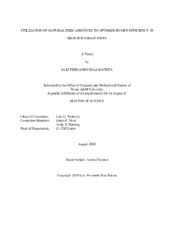| dc.description.abstract | In the last two decades, two major public perceptions have been assigned to animal agriculture: antibiotics and ‘non-natural’ products in domestic animal diets are hazardous to human health, and increased greenhouse gas concentrations are the result of cattle production. Therefore, the exploration of natural feed additives and their effects on ruminant performance and resultant greenhouse gas emissions could identify possible alternatives to replace these products. In the first trial, I investigated the utilization of seven encapsulation methods of branched-chain volatile fatty acids (BCVFA) on in vitro gas production dynamics of Brachiaria brizantha hay incubated with or without the addition of casein and cysteine (C&C) as a nitrogen source. The inclusion of C&C altered fermentation parameters of salts of BCVFA, indicating that the optimal level of inclusion is dependent on N availability. This trial indicated that the utilization of S1 salt favored maximal total digestible nutrients (TDN) compared to other combinations of encapsulation materials. The utilization of natural plant secondary compounds as feed additives in animal nutrition has been extensively studied because of their ability to modify digestive and metabolic functions. Condensed tannin (CT) supplementation can potentially alter ruminal fermentation and mitigate methane (CH4) emissions. In the second trial, I evaluated the effect of quebracho CT (QT) extract at four levels (0, 1, 2 and 3% of dry matter; QT0, QT1, QT2, and QT3) of inclusion within a roughage-based diet on overall fermentability and CH4 production utilizing the in vitro gas production technique. In situ dry matter digestibility increased linearly (P = 0.048) as QT inclusion increased. Total volatile fatty acid concentration did not differ among the treatments (P = 0.470); however, ruminal NH3 and blood urea nitrogen (BUN) decreased linearly as QT inclusion increased (P < 0.075), suggesting a reduction in protein deamination in the rumen. CH4 production was reduced (P = 0.001) for the highest level of inclusion QT3 compared to no QT and QT2 on Days 0 and 28, respectively. Moreover, CH4 production per gram of neutral detergent fiber (NDF) digested tended (P = 0.054) to decrease linearly as QT inclusion increased. Thus, the inclusion of QT appears to improve animal performance and reduce CH4 emissions. However, future studies are required to determine the practicability of QT utilization. | en |


